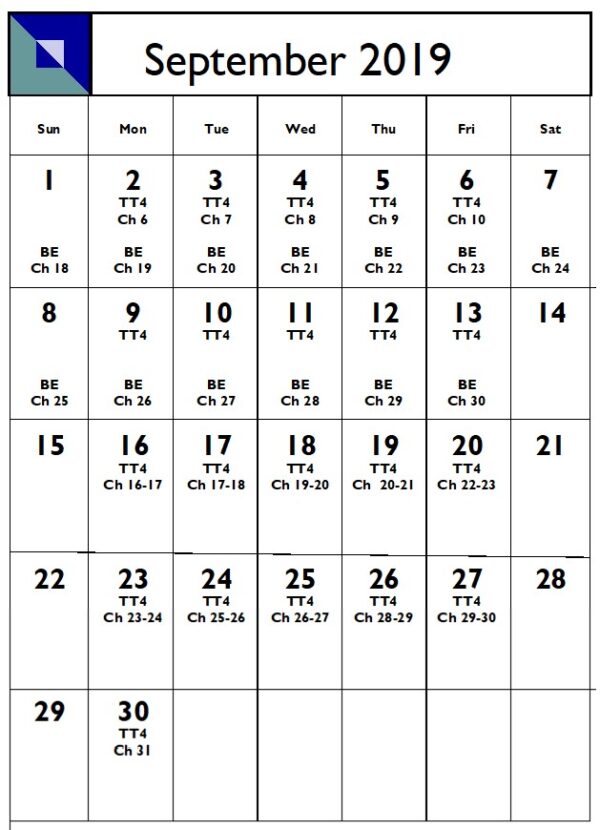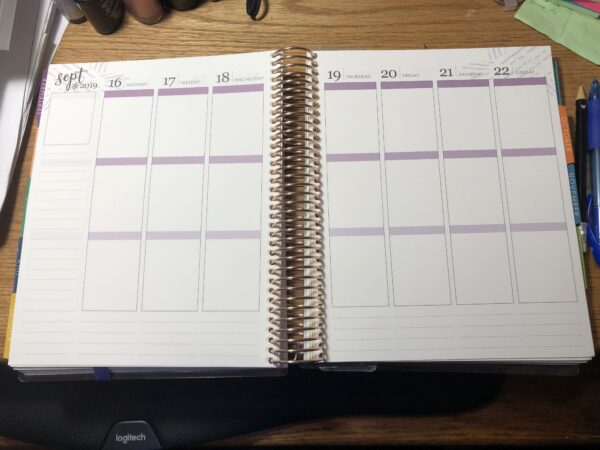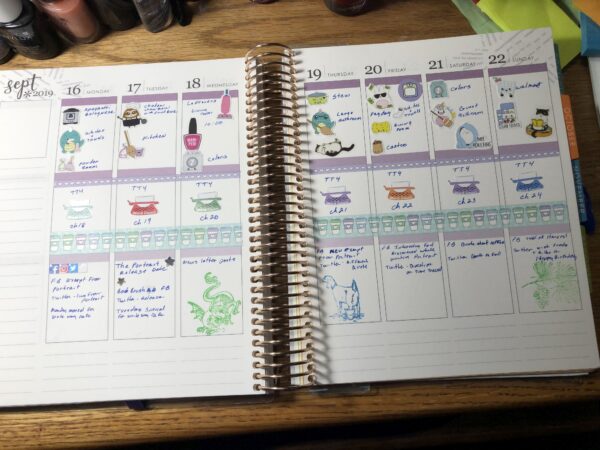Overwhelmed? Break Down Tasks for Writing and Life — Guest: Augustina Van Hoven

The vast majority of us are too busy. Between writing, family, day job, and household obligations, it’s easy to feel overwhelmed. Add in that our writing life consists of big projects like “write a novel” or “publish a book,” and it’s sometimes a wonder that we don’t just curl up in a ball and give up.
Worse, the stress of trying to keep everything under control can scare our muse into the fetal position. Not good for our creativity.
Yet at the same time, if we get organized with our writing projects, far too often other aspects of our life suffer. The laundry remains unwashed, or we forget to put food on the table (or even go shopping to stock the fridge).
So how do we keep all aspects of our life organized? And how do we keep the daunting view of those big projects from overwhelming us?
Luckily we have Augustina Van Hoven here to help. She’s sharing her system for breaking big tasks into manageable chunks—for writing and for the rest of our responsibilities.
Please welcome Augustina Van Hoven! *smile*
*****
Putting It All Together —
And Keeping It That Way
By Augustina Van Hoven
Like so many women, I wear many hats: wife, mother, grandmother, accountant, and author. With each of these titles comes many tasks and responsibilities. Handling all of them and completing them on time is not easy.
Some days I felt like I was trying to juggle fifty balls and dropping every other one. Each time I forgot a task or missed an appointment, I became more stressed and frustrated until I felt like I was drowning, along with my creative muse. Something had to be done.
Over the years I put together a plan for organizing the different aspects of my life and holding it all together so my family got fed, my house got cleaned, my garden got planted, and my books got written. It took a lot of trial and error, but I finally came up with a system that works.
Step #1: Break Obligations Down—From Big Picture to Smaller
It all begins with a full year calendar. Each one of us has special days and events in our lives that change our normal routines and schedules.
How can we break big projects into manageable chunks? @augustinavhoven shares examples for life and writing Click To TweetThe first thing I do is look at the calendar and write down month by month what those days are. I list birthdays, anniversaries, graduations, holidays, conferences I plan to attend, and vacations. I set the list aside but refer back to it with each schedule I put together.
The next thing I do is create a calendar for each month. I do this on Microsoft publisher, but any plain calendar would work as long as you can make copies of it. This monthly calendar is my worksheet for each project or task.
Step #2: Create To-Do Lists for Each Aspect of Our Life
Example #1: Breaking Down Food-Related Chores
Every family has to eat. Before I put my system together, I often had to get takeout for my family because I’d forgotten to thaw the meat. Or I’d be in the middle of cooking something only to discover I was out of tomato paste or the sour cream looked like a science experiment.
- Plan by the Month
Now I plan out my meals a month in advance. It may seem like overkill, but there is method to my madness. This way, I can refer back to my full year calendar and note any special occasions that mean we’re going out to eat or I have to make something special. I can also make sure I don’t have all beef or all chicken in one week.
- Plan for Shopping
Once I create the list, I can prepare my grocery list. I consult the recipes for each dish and check the ingredients against what I have in stock, ensuring I’m not missing something when I go to cook.
- Plan for Advance Prep
It also lets me know what preparations I can do in advance, such as cutting bell peppers or onions. I set aside some time over the weekend to do any chopping and store the pre-measured items in plastic tubs. This saves me a lot of time during the week.
- Go Shopping
I’ve gone through my store and noted how the grocery aisles are laid out. I created a spreadsheet of my most used items as they are displayed in the store. (Note from Jami: Click on images to view larger, and newsletter readers can click through to the post to view example pictures.)
Because I know what I’m cooking next week, and I know what I have in my pantry, I can easily to figure out what I still need to buy. This system helps me cut down on waste. It also lets me compare items on sale with my monthly meal list, so I can take advantage of sale prices.
Example #2: Breaking Down Household Chores and Projects
Cleaning is another task I’ve broken down into smaller parts to make it more manageable. I’m one of those people, who, when faced with a task they really don’t want to do, find every excuse in the book to avoid it. I really think there should be an eighth deadly sin, procrastination.
- Cleaning: I’ve set it up so I clean a room each day, with some of the larger rooms split up over more than one day. Every three weeks, my entire house has been thoroughly cleaned rather than waiting for the whole place to look like the Aegean stables.
- Laundry: Other tasks such as laundry are scheduled on specific days, so we never run out of clean clothes or towels. All of this is first plotted out on monthly calendar, taking into account special days.
- Financial: Finances are handled in the same way. I use a monthly calendar and list the days when bills are due. I also mark the days we get paid and the days my royalty payments come in. In addition to the due date, I mark the day that the payment must be sent so it doesn’t arrive late.
- Hobbies: My main hobby is gardening. I use my monthly schedule to plan out what days I need to plant and which raised bed I need to weed. This way, I spent an hour or less in the garden each day, my crops are planted on time, and I don’t get overrun with weeds.
- Special Activities: Other projects are given their own calendar. For example, how many rows per day do I have to crochet to finish a baby blanket in time for the baby shower?
Example #3: Breaking Down Writing-Related Activities
When it comes to drafting books, I handle things a little differently:
- First I make a list of the number of books I plan to publish that year.
- I grab a clean copy of the yearly calendar. I mark out the tentative release dates for my books and then consult my special occasion yearly calendar. Some of the special occasions will be not writing days and they need to be blocked out.
- I then go back to the calendar and mark the number of writing days necessary for each novel and novella.
I had an epiphany when it came to promotion and social media. In another life, I used to work on political campaigns in a variety of roles, from simple volunteer to paid strategist. I’ve worked on everything from school bond elections to gubernatorial and congressional races.
How can we improve our writing by getting more organized across our life? @augustinavhoven shares her insights Click To TweetThe heart of any political campaign is the backward calendar. You start with election day and work your way back to the current date. You mark when you need to have yard signs out, do your literature drops and media buys, chase the absentee ballots, and do fundraisers and community events.
This way you know how many fundraisers you need to do to have enough money to pay for everything. You can also see when you have to order printing and advertising, so everything is ready when you need it.
Releasing a book follows much the same principle. You begin with your tentative release date and work your way backward.
This way you know when to ask for reviews, take out ads, to put up your preorders, order your book covers, and finish your book so that your editors have enough time to do substantive edits, copy edits, proofreading, and formatting. Once you’ve gathered all this information, you know when to start your book.
Step #3: Organize Our Week
By the end of all this planning, you have yearly sheets and monthly sheets showing when all the things must be done. At this point, I take all the information and put it in one place, a planner.
I use an Erin Condren Life Planner (on Amazon) because each day of the week is broken down into three sections. This allows me to use the top section as my personal household and appointments area, the middle section for writing and edits, and the bottom section for promotions and social media.
When the planner is laid out, I can have a little fun and get creative. I use stickers, stamps, and washi tape to decorate the sections. I’ve attached an example of what a week looks like.
Step 4: Customize Plan to Adapt to Our Needs
I hope you find my organizational system helpful. Everyone is different, and this system can be adjusted your individual tastes.
You don’t need to use everything that I do. But this is what I found works for me and helps me juggle all my tasks. And keep my muse, if not happy, at least on the job.
*****
 Augustina Van Hoven was born in The Netherlands and currently resides in the Pacific Northwest with her husband, two dogs and three cats. She is an avid reader of romance, science fiction and fantasy.
Augustina Van Hoven was born in The Netherlands and currently resides in the Pacific Northwest with her husband, two dogs and three cats. She is an avid reader of romance, science fiction and fantasy.
When she’s not writing she likes to work in her garden or in the winter months crochet and knit on her knitting machines.
Website | Twitter | Facebook | Pinterest
*****
 About A Way Back
About A Way Back
Time travel only seemed like a good idea.
Like many before her, Sarah Anderson is determined to make her fortune in the Wild West. She loads up her skirts with twenty-first-century necessities, gives her fiancé a kiss, and takes the leap. Only to land in the wrong decade. She’s lucky. She finds a job. But until she can save enough pennies for the return trip, she must contend every day with the fear of discovery, slop buckets, and roving hands.
Jack Sinclair returns from yet another business trip only to learn that his fiancée has left him for another time. They are now many miles and two centuries apart. Jack is stunned. But only for a moment. He sets out to find Sarah and bring her back home. Or die trying. Jack’s only fear is that he might be too late to save the love of his life.
Amazon | Barnes & Noble | iTunes | Kobo
*****
Thank you, Augustina! We might have heard the “eat an elephant one bite at a time” quote about breaking big projects into smaller tasks, but it’s great to get this overview of how that concept can help us stay organized and in touch with our muse.
As I mentioned in the introduction, it’s hard to be organized at all, much less with writing and day job and family and household stuff and friends and hobbies and, and, and… Hopefully Augustina’s examples help us all see how to apply a bit of organizing structure to all those pieces.
My life has been chaos the last few years due to my health issues, but Augustina is right that being overwhelmed and stressed due to all that we have on our plate is no way to be creative (as I know far too well). I’ve been looking at a few tools like planners to try to tame my chaos a bit, so wish me luck. *smile*
Do you struggle with disorganization or feeling overwhelmed? Do you ever feel like organization is a game of Whack-a-Mole, and as soon as one aspect of your life is going well, everything else falls apart? Does those feelings make it harder to get into a creative mindset? Do you have other advice or tips to resolve those problems? Do you have any questions for Augustina?
Pin It




I was a single parent with my own house and yard, elderly parents with their house and yard, and working full time. I cannot agree more with the monthly menu! It was soooo nice to just check the next day’s list, pull out whatever was frozen, and be ready to go the next day. I did all my shopping on one day each month, unless something was majorly on sale. I threw a load of laundry in the washer before I left for work, dumped it in the dryer when I got home – never without clean clothes. Where I use to book Cub Scouts, soccer coaching, and helping my folks, now I could book writing time (but since I’m now an empty nester and only work 3 days a week, writing time is pretty much whenever I want ti :D).
It does seem like a huge job getting that initial organizing done – but it is so worth the time when tasks are ‘automatic’ and you know exactly what’s coming (as much as that’s possible, anyway). And once it’s done, it’s really only the “special dates” that need to be adjusted for each year. Believe me, it really makes those unexpected problems much easier to handle because everything else already is.
It’s so true, being organized makes everything run smoother. When something comes up to disrupt a day it’s easy to get back on track and you don’t feel like your whole world is falling apart.
I looked at the Erin Condren planners, and bought a similar one, but had to abandon it as the spaces were too small (for me.) I use a larger planner with much larger blocks for each day now.
I’ve set up a schedule where I batch things: site updates on Mondays, newsletter writing/sending Tuesdays, etc. That’s been helping a lot. There’s always so much to do as a self-publisher!
Batching is a good way to do all the promotion things we have to do. Planners are a personal choice and there are a lot to chose from. I’m glad you found one that works for you.
What a helpful system! I think we tend to underestimate how much difference it makes having the little everyday things organized to run smoothly without requiring much mental attention.
Coincidentally, I’m in the last week of a ten-week experiment with ten different productivity methods – finding what works best for me. One of my findings so far: the methods which have flexibility for days when you’re sick and tired are best for avoiding that draining “falling behind” feeling.
And A Way Back sounds like a fascinating set-up 🙂
Building sick days into your writing schedule is part of the plan. I try to give myself an extra week in my writing schedule for those days when I don’t feel well, something unexpected comes up or my muse flies the coop.